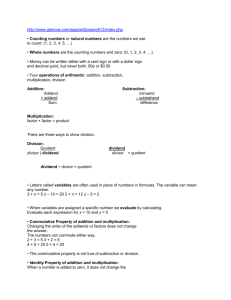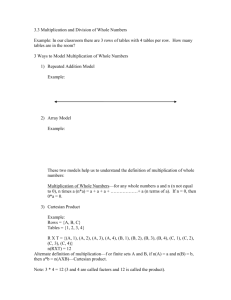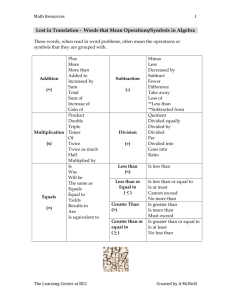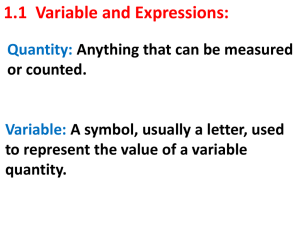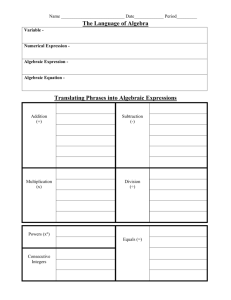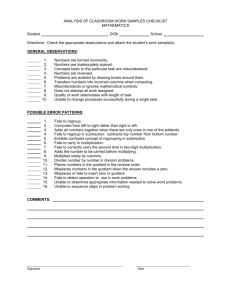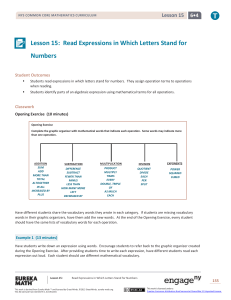New York State Common Core Mathematics
advertisement
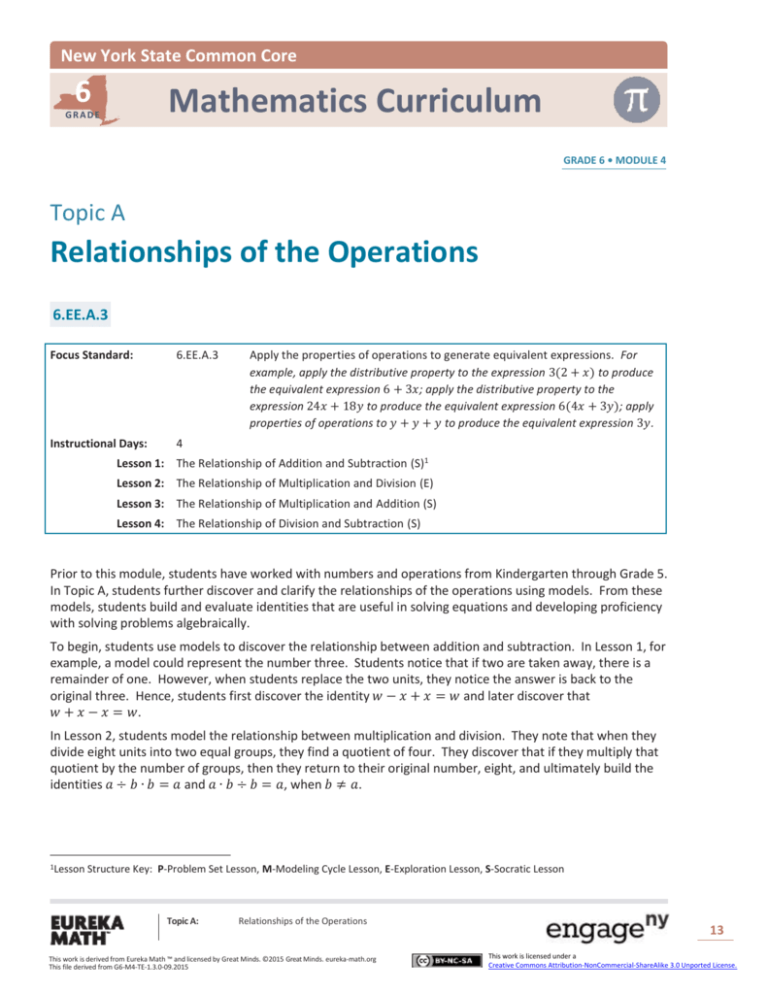
New York State Common Core 6 x Mathematics Curriculum GRADE GRADE 6 • MODULE 4 Topic A Relationships of the Operations 6.EE.A.3 Focus Standard: 6.EE.A.3 Instructional Days: 4 Apply the properties of operations to generate equivalent expressions. For example, apply the distributive property to the expression 3(2 + 𝑥) to produce the equivalent expression 6 + 3𝑥; apply the distributive property to the expression 24𝑥 + 18𝑦 to produce the equivalent expression 6(4𝑥 + 3𝑦); apply properties of operations to 𝑦 + 𝑦 + 𝑦 to produce the equivalent expression 3𝑦. Lesson 1: The Relationship of Addition and Subtraction (S)1 Lesson 2: The Relationship of Multiplication and Division (E) Lesson 3: The Relationship of Multiplication and Addition (S) Lesson 4: The Relationship of Division and Subtraction (S) Prior to this module, students have worked with numbers and operations from Kindergarten through Grade 5. In Topic A, students further discover and clarify the relationships of the operations using models. From these models, students build and evaluate identities that are useful in solving equations and developing proficiency with solving problems algebraically. To begin, students use models to discover the relationship between addition and subtraction. In Lesson 1, for example, a model could represent the number three. Students notice that if two are taken away, there is a remainder of one. However, when students replace the two units, they notice the answer is back to the original three. Hence, students first discover the identity 𝑤 − 𝑥 + 𝑥 = 𝑤 and later discover that 𝑤 + 𝑥 − 𝑥 = 𝑤. In Lesson 2, students model the relationship between multiplication and division. They note that when they divide eight units into two equal groups, they find a quotient of four. They discover that if they multiply that quotient by the number of groups, then they return to their original number, eight, and ultimately build the identities 𝑎 ÷ 𝑏 ∙ 𝑏 = 𝑎 and 𝑎 ∙ 𝑏 ÷ 𝑏 = 𝑎, when 𝑏 ≠ 𝑎. 1Lesson Structure Key: P-Problem Set Lesson, M-Modeling Cycle Lesson, E-Exploration Lesson, S-Socratic Lesson Topic A: Relationships of the Operations This work is derived from Eureka Math ™ and licensed by Great Minds. ©2015 Great Minds. eureka-math.org This file derived from G6-M4-TE-1.3.0-09.2015 13 This work is licensed under a Creative Commons Attribution-NonCommercial-ShareAlike 3.0 Unported License. NYS COMMON CORE MATHEMATICS CURRICULUM Topic A 6•4 Students continue to discover identities in Lesson 3, where they determine the relationship between multiplication and addition. Using tape diagrams from previous modules, students are assigned a diagram with three equal parts, where one part is assigned a value of four. They note that since there are three equal parts, they can add four three times to determine the total amount. They relate to multiplication and note that three groups with four items in each group produces a product of twelve, determining that 3 ∙ 𝑔 = 𝑔 + 𝑔 + 𝑔. Finally, in Lesson 4, students relate division to subtraction. They notice that dividing eight by two produces a quotient of four. They experiment and find that if they subtract the divisor from the dividend four times (the quotient), they find a remainder of zero. They continue to investigate with other examples and prove that if they continually subtract the divisor from the dividend, they determine a difference, or remainder, of zero. Hence, 12 ÷ 𝑥 = 4 means 12 − 𝑥 − 𝑥 − 𝑥 − 𝑥 = 0. Topic A: Relationships of the Operations This work is derived from Eureka Math ™ and licensed by Great Minds. ©2015 Great Minds. eureka-math.org This file derived from G6-M4-TE-1.3.0-09.2015 14 This work is licensed under a Creative Commons Attribution-NonCommercial-ShareAlike 3.0 Unported License.

